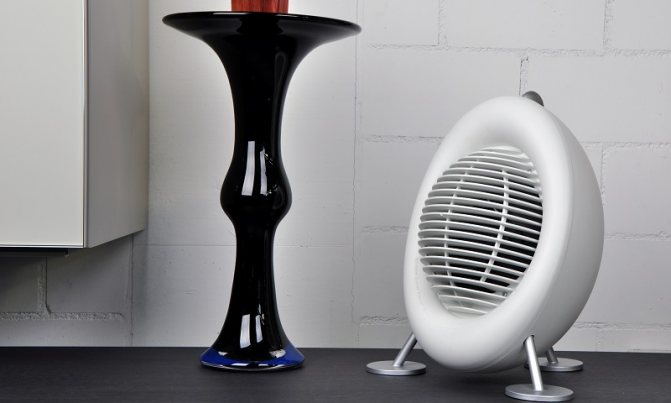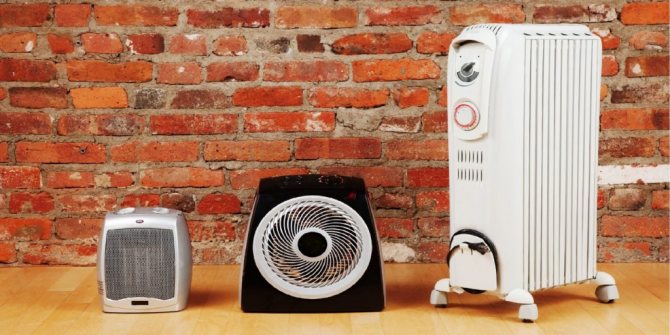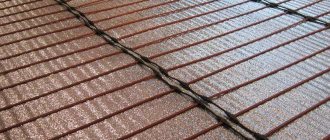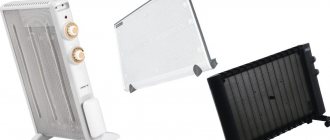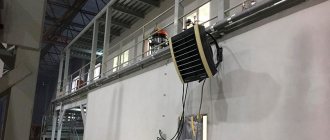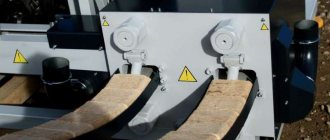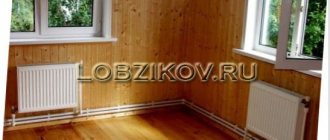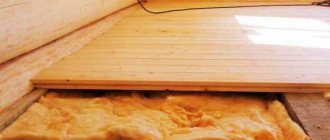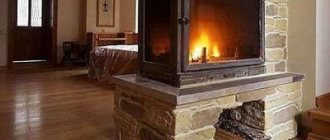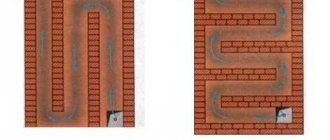Fan heaters are designed for local heating of residential and work premises, offices. They are not suitable for continuous work, therefore they are used only where people stay for a relatively short time.
A household heater for an apartment or a country house is usually a fairly simple device. Of course, sometimes you can find high-tech heaters with remote control from a smartphone, but in most cases nothing complicated can be found in such devices.
Accordingly, it will not be too difficult to choose a suitable heater. The main thing is to decide on the main parameters. First of all, this is the type of heater and its power, and secondly, additional features and options.
Principle of operation
The main components of a fan heater are a heating element and a fan. In the role of the first, a metal alloy in the form of a spiral, ceramic plates or heating elements is used.
Individual models of fan heaters contain several heating elements of the same type.
The main percentage of heat fans is powered by the electrical network.
When the device is connected to it and the operating mode is turned on, the heating element begins to gain temperature, generate heat and heat the air nearby, and the fan pushes the already heated air out.
Warm air is gradually distributed throughout the room.
Which is better - a heat curtain or a convector
Here, the difference is also determined by the principles of the device. So, the convector heats the air according to a certain principle: the air masses pass through the heating elements and rise, and instead of them new, cold ones are heated. Such a device is mounted as low as possible to the floor so that it works effectively. It is often aesthetic, silent, mobile and even programmable, has a built-in thermostat and does not burn oxygen. These are classic domestic space heaters with low ceiling heights.
If the room has a high ceiling and new streams of cold air constantly appear from the street, then the convector will not cope with the load, since its heating elements, although they have a large area, are still not powerful enough.
If it is important to prevent drafts, then just heat curtains are used. They force heated air into the doorway. Particularly useful where these openings are wide and often open. Moreover, there are no restrictions on the purpose of the premises. It can be either a living space or a warehouse.
Types of fan heaters
Classification by type of heating element:
- A spiral made of an alloy of metals, most often it is nichrome. Fans with such a heating element are the cheapest.
- Ceramic plates. They are considered the safest.
- TEN (tubular electric heater) - a heating element is built into a metal pipe. A substance with high heat conductivity is also put there. The metal spiral heats up more strongly than the ceramic plate, so a device with such a heating element heats up the room more. But at the same time, combustion products (dust particles) are released into the air.
Ceramic plates do not have this effect, which is why they are considered the most harmless. TEN heaters are used to heat spacious rooms, as their performance is very high.
Convectors
In its work, such equipment is similar to a fan heater. Only in this case, the convector first passes air through the element, which heats it up, and then blows it around the room.What's the difference? In the absence of a fan that will distribute warm air throughout the room. In this case, the propagation process occurs due to convection, which lifts the warm air upward. This is also some disadvantage of this device - heating is carried out slowly. Convectors look like panels with gratings. In fact, convectors can be different, depending on what kind of heating element they have:
- heating elements (tubular electric heaters) are an inexpensive device known to many people. Quite reliable, proven over many years of service and inexpensive device;
- needle convector - heats up very quickly, however, it is subject to a serious drawback - it often burns out;
- monolithic convector - it works the longest, but it is also the most expensive. Structurally, it is part of the body, therefore, when heated, it expands in proportion to it, which lengthens the duration of its operation for many years. The best convector is definitely solid, despite its cost.
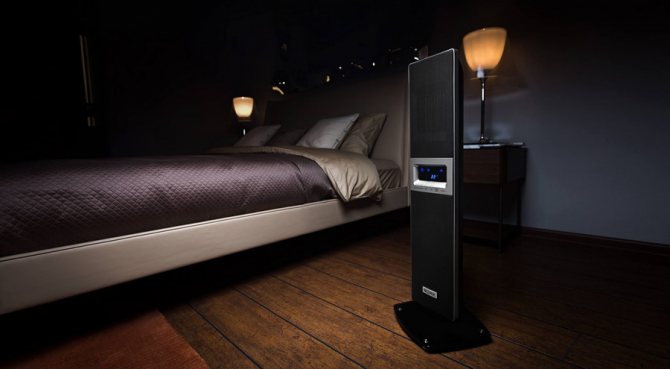
Thermostat - it is the main device installed in electric convectors. These devices are as follows:
- mechanical. These are cheaper products, but they consume a lot of electricity, and also cannot constantly maintain a certain heating temperature. Emit clicking sounds during operation. Basically these thermostats have a manual switching mechanism. These devices are the most affordable on the market;
- electronic convectors work silently, consume little electricity. There are models with remote control.
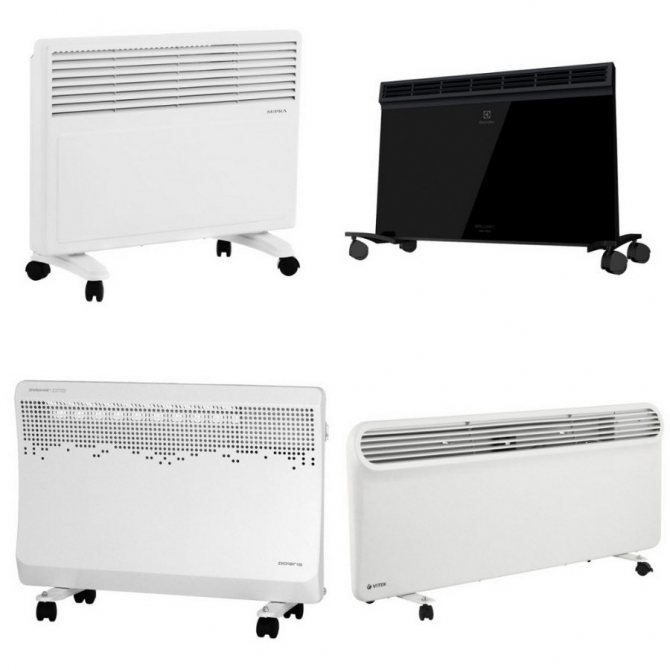

Features of the
Convectors are usually wall-mounted. They can be installed under a window, as a well-known radiator, or anywhere else. Many models can be installed on the legs that come with them. Electric converters have a parallelepiped shape with different sizes - low, long, high, narrow. They are often placed under windows in order to cut off cool air from the windows. Convectors with waterproof casing can be used in bathrooms.


The electric convector can be supplied with some useful functionality:
- when dropped, it turns off. This is important when the convector is left unattended;
- ionizes and humidifies the air;
- filters the air, removing dust from it that floats in the air.
The best version of the convector is one that has a monolithic heater, and electronic control cannot be ignored. Such a heater will do a good enough job of maintaining a comfortable temperature, and at the same time it will not use a lot of electricity.
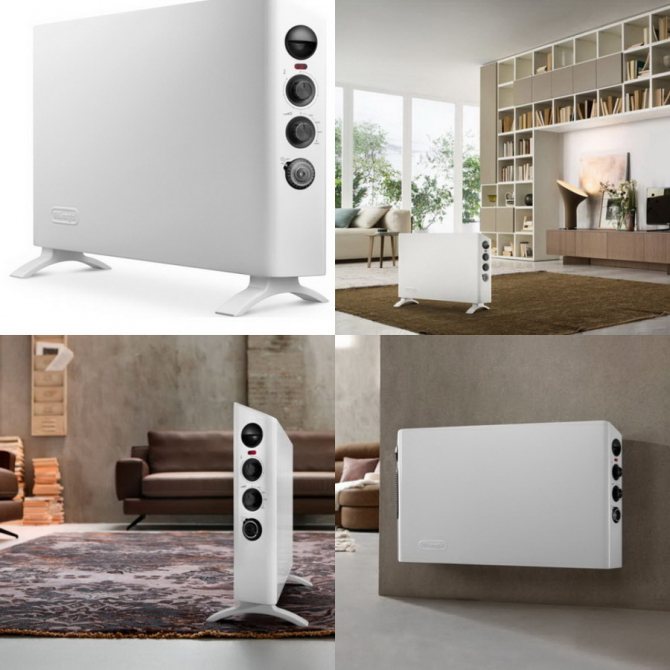

Additional functions
The safety of thermal equipment is ensured not only by correct operation, but also by some built-in functions and elements:
- The regulator helps to switch between heating elements of higher or lower power, if there are several of them in the heater.
- Expensive models of thermal equipment have timer or delayed start functions.
- The splash-proof feature is useful if the fan is to be used in a kitchen or bathroom.
- The thermostat function cools the appliance when it gets too hot.
- A special relay will automatically turn off the fan heater if it falls.
Evgeny Filimonov
Ask a Question
Fan casing is usually made of plastic, so horizontal operation can lead to melting of the casing at best and fire at worst.
Complete set and accessories
The complete set of fan heaters differs according to the type of installation:
- Floor-standing fan heaters are made static or mobile. The first ones are equipped with strong legs, the second ones - with legs or wheels.
- Wall-mounted appliances are most often installed in small spaces. They are only stationary and are attached to the wall, often a remote control is included in the kit.
- Wall or ceiling heat fans are fixed to the wall or ceiling surface using a special bracket or mounting bracket.
Some accessories for heating fans:
- Fan speed control device helps to avoid overload and breakage.
- To increase the distance that a stream of warm air overcomes, a special confuser is sold in stores.
- Controllers that give commands and switch functions are built into the instrument during assembly or sold separately.
- For large models, special trolleys are sold, which makes the stationary floor heater mobile.
- Thermostats, like controllers, are sold separately.
- The mounting console turns the device body in any direction.
Evgeny Filimonov
Ask a Question
Typically, heating equipment is powered by electricity. However, water-powered air ventilation devices are produced. Hot water gives off heat to the heater, and due to this, it works.
Which is better to choose - a fan heater or a convector heater?
It is very easy to get lost in today's widely represented heating market. Many consumers get lost with so many models. However, in the class of electrical devices, the leading positions are occupied by convector heaters and fan heaters. They are the most affordable, suitable as a supplement to batteries or for temporary use, for example, in the country or in the garage. However, they also have a number of significant differences, which allows you to choose one or another model of a fan heater or convector.


What is a fan heater?
An electric fan heater is the simplest and most inexpensive heater option available. They are desktop and floor-standing, of completely different sizes and configurations, with a capacity of 1-3 kW. The essence of their work is as follows: the air blown by the fan is warmed up by passing through the heating element. Thus, the device in a short time can heat up a sufficient area of space. And with a small room such as a garage, the device will cope even faster.
The difference in the type of design determines the presence of several types of fan heaters:
- with an open heating element;
- with tubular electric heater;
- electric heater in the form of ceramic tiles.
Options with ceramic elements have proven themselves well, thanks to their environmental friendliness and versatility of their use.
The advantages of operating fan heaters include:
1.Compact size, able to fit into any interior;
2. device mobility;
3. a variety of modes and additional built-in functions;
4. even distribution of warm air in the room.
When choosing such a device, you should pay attention to the presence of a sponge filter for coarse air purification, as well as an autonomous shutdown system in case of possible overheating of the equipment.
Features of convection devices
Convection heaters, as the name implies, operate on the principle of natural air convection. Circulating in the room, cold air flows, passing through the housing with a heat exchanger, are warmed up at the required temperature and at the outlet are evenly distributed in the space. The devices have a compact, ergonomic design, a flat parallelepiped body. There are models only 3-4 cm thick. They are manufactured as floor-standing, wall-mounted, universal and even built-in equipment. The rated power is 0.25-2.5 kW.There are also modifications with a built-in infrared heater.
Pros of a fan heater
- A spacious room is quickly heated. The heating rate increases depending on the power of the device. The speed leaders are heat guns.
- Safe when used correctly. In modern devices, the necessary devices are installed that will not allow the fan heater to melt or catch fire.
- The most fireproof and environmentally friendly equipment is considered to be with a ceramic heating element.
- A wide choice of designs will allow you to choose a fan heater that would suit the interior of the room.
- Mobile models are transferred from room to room.
What is better convector or fan heater: comparative overview of units
When choosing a heater, any person is somewhat confused by the number of models sold by manufacturers of heating equipment on the market. The great popularity of modern fan heaters among buyers is explained quite simply. These inexpensive household appliances are able to warm up the air in the room in a short time of operation, thereby providing a comfortable microclimate for the people there. Floor-mounted and wall-hung convectors will take a little longer to achieve the same result. But convector heaters can work longer, providing full heating of a small country house. For a meaningful choice of equipment, you need to get acquainted with both types of heaters. Then it will become clear which is better: a convector or a fan heater.
The device and principle of operation of the fan heater
Electric fan heaters are considered the simplest and most affordable heating devices for most consumers. Floor-standing and table-top models are available. The fan, driving a large volume of air through the heating element, provides rapid heating of the room. The heating element can be made in the form:
- open electric coil (operating temperature - 800 ° С);
- tubular electric heater (200 ° C);
- ceramic tiles (less than 200 ° C).
It is better to purchase fan heaters with a ceramic heating element, since these models provide "clean heat". The air is not contaminated with combustion products.


The latest models of fan heaters will not only provide fast and uniform heating of the room, but also become an excellent element of interior decoration.
The undoubted advantages of fan heaters include: their efficiency, minimum price, speed and uniformity of distribution of heated air throughout the room, compact size, elegance of design and integration into any interior, availability of additional functions and mobility.
The disadvantages of using these household appliances include increased noise that appears when the engine is running at high speeds. Provides inconvenience and an unpleasant odor arising from the combustion of dust and debris falling on an open heating coil.
When you go to the store, you just have to trust the many years of consumer experience:
- Choose fan heaters from the following manufacturers: Electrolux, De'Longhi, Ballu, Rolsen, Polaris, Timberk, Supra, Bork, NeoClima, General Climate, Saturn, Scarlett.
- Pay attention to the type of heating element, give preference to models with "ceramics".
- Buy appliances with a coarse sponge filter installed on the back of the appliance.
- Take into account the power of the household appliance (from 1 to 3 kW) and the presence of a function to regulate it.
- Safe operation of the device (protection against overheating, automatic shutdown in case of overturning).
disadvantages
- They make a lot of noise during operation, but in stationary models there are sometimes silent fans.
- When dust particles enter the housing, they become combustion products, which gives off an unpleasant odor. This is typical for models with a spiral heating element.
- The operation of the devices leads to dry air. Considering that heaters are used mainly in winter, when the air itself is dry, this disadvantage is greatly exacerbated.
- The least dry air is provoked by fans with a ceramic type of heating element.
- Dust lying on the surface of objects rises under the influence of air jets.
How to choose a fan heater
- The main percentage of heat fans is made of plastic. The main requirement for the body is strength. This ensures both durability and safety of use.
- The required power is calculated according to the area of the largest room in which the fan heater is supposed to be installed. It is derived from the calculation of 1000 watts / 10 sq. m.
- You need to choose a mobile or stationary device based on your needs. If heating equipment is required in several rooms, a portable fan will be needed. Stationary models are more powerful and generate less noise.
- The noise level also depends on the design of the fan. The "quiet" type is tangential. The axial fan does not have such an advantage.
- Don't forget about safety. Fall shutdown, overheat cooling, safety heating element - these parameters will protect users from fire.
- Fan heaters use two types of ceramics: glass and metal. Of these, preference should be given to glass.
- The maximum number of operating modes in modern fans is 3. Such a number of modes makes the operation of the fan-heater comfortable and economical for users.
The best outdoor fan heaters
Compact portable heaters are very popular - they are installed on the floor, bedside table or table. They are lightweight and easy to use, and the assortment includes a variety of shapes and designs of devices. The blown out air rises on its own, evenly warming up the entire room.
Tefal Intense Comfort Hot SE9420
5
★★★★★
editorial estimate
100%
buyers recommend this product
See overview ▶
A ceramic heater with a power of 2400 W with electronic control is made in the form of a vertical column. It comes with a remote control for remote setting modes. The appliance provides a powerful stream of hot air to heat a room of 25 squares. Smart Technology maintains optimal temperatures and regulates heating to create the ideal indoor environment.
This fan heater is the quietest in the manufacturer's range - 42 dB. Of the possibilities, it is worth noting an electronic timer, a delayed start, a 90-degree blowing angle and 3 power modes.
Pros:
- Compact size and elegant design;
- Electronic control with remote control;
- Ceramic heating element;
- Safe and reliable;
- Maintains the set air temperature in the room;
- 3 power levels, there is an eco-mode;
- Wide angle of airflow.
Minuses:
- Expensive (price without discount is almost 11 thousand).
The device is made in a stylish design, does not take up much space and heats a room up to 20-25 m2. It is also able to maintain the air temperature at +19 degrees and work in an economical mode, reducing the electricity bill.
Bork O706GG
4.8
★★★★★
editorial estimate
90%
buyers recommend this product
A miniature and original fan heater with a power of 2000 W can work continuously from 1 to 7 hours, heating a room up to 18-20 square meters. A durable and reliable ceramic element is taken as a heating base. The flow rate can be adjusted - the touch buttons on the lid of the device are intended for this and one of two levels is selected.There is a swivel mechanism that rotates the device 360 degrees in the horizontal plane. The noise level is 45 dB and does not cause discomfort.
Pros:
- Stylish design and compact size;
- The mechanism rotates the device 360 degrees;
- Beep when turned on;
- Automatic shutdown when overturning and overheating;
- High power;
- Ceramic heater;
- Works continuously up to 7 hours.
Minuses:
- Short cord;
- There is no automatic switch-on after de-energizing.
For comfortable transportation of the device, there is a carrying handle on the case. The heater can be used as the main heat source for a relatively small room (preferably up to 18 m2).
Midea MFH-2901
4.7
★★★★★
editorial estimate
85%
buyers recommend this product
Another unit for heating small areas no more than 10-15 m2. For the user, 3 operating modes are offered, which are set using a mechanical regulator, and the temperature is also selected. Heating power 1800 W. There is a shutdown in case of overheating and overturning, a carrying handle is provided on the lid. The size of the device allows it to be installed on a table or bedside table to heat the room from the center.
Pros:
- Simple controls;
- Reliable mechanical switch for temperature and flow rate;
- Original design;
- Work indicator light;
- Carrying handle;
- Tabletop and outdoor installation;
- 3 operating modes;
- Shutdown on rollover and overheating.
Minuses:
- Short cord.
Despite the power of 1.8 kW, the fan heater heats up the room slowly and is suitable only for small rooms: bedrooms, kitchens, children's rooms.
Hyundai H-FH3-15-U9204
4.6
★★★★★
editorial estimate
82%
buyers recommend this product
An inexpensive Hyundai fan heater can heat a study or bedroom. It is equipped with a mechanical switch and sintered metal heating element. There is only one mode, but it is enough for a room with an area of 13 squares. There are no additional bells and whistles and functions in the device, even there is no shutdown in case of overheating. The power of the device is 1300 W.
Pros:
- Compact and easy to use;
- The collection has three colors - white, red and gray with blue edging;
- Simple controls;
- Tabletop and outdoor installation;
- Sintered heater does not dry the air;
- Exclusive design.
Minuses:
- No additional features;
- Only one operating mode.
The small-sized heater allows desktop and floor installation, it weighs only 900 grams and does not take up much space. Not a bad option for heating a small room.
READ ALSO
8 best wall heaters
Exploitation
In order for the device to serve as long as possible, follow some operating rules.
- Periodically wipe dust off the surface of the thermal fan case.
- Clean the air intake grilles with a vacuum cleaner.
- A regular inspection will help prevent malfunctions.
Pay particular attention to the operating rules related to fire safety:
- Before cleaning the fan, unplug it from the power supply and wait for it to cool down.
- The fan heater must not be connected to an electrical network without grounding.
- Do not use the fan heater in rooms with air humidity exceeding 93%, in a chemically and explosive environment.
- Do not drop the fan heater or handle it by the power cord.
- Check the continuity of the wire before each connection.
- It is not safe to use the fan heater in close proximity to water, even if it has a splash guard installed.
- Do not place the fan on carpet.
- Never cover the fan with fabrics or obstruct the movement of air currents, as this may result in a fire.
- If the fan is not ceiling mounted, it is also unsafe to operate it horizontally: the plastic case melts or catches fire.
- There should be at least half a meter between the fan heater and the nearest objects.
- The appearance of sparks and too frequent activation of the temperature controller indicate a malfunction. The fan heater cannot be used in this state.
Guarantee
- The standard warranty period for the operation of the fan heater is 12 months from the date it was sold. From the date of production, it is no more than 24 months.
- In some cases, an extended product warranty is provided, which is 60 months from the date of manufacture. You can check the extended warranty at the service center, in the store or on the manufacturer's website.
- Upon purchase, a warranty booklet with tear-off coupons is provided. If the instruction manual does not contain a mark of a trading company, the warranty period starts from the date of production.
- The owner reserves the right to free repairs in the service while the warranty period is valid. The workshop will withdraw the tear-off coupon after each repair. Accounting is kept in the guarantee book.
- In case of violation of the rules of operation, the heating unit is automatically removed from the warranty. From this time on, the repair work is carried out at the expense of the buyer.
- The exchange of goods under warranty takes place in accordance with the rules that apply at each outlet.
The buyer loses his warranty rights if:
- the product certificate and warranty card are filled in incorrectly;
- passport or warranty card is missing;
- the product was used for other purposes or in violation of the rules of operation;
- the product was damaged mechanically, chips, cracks or deformation of the case were found on it;
- traces of self-repair or any other implementation were found;
- the design of the fan heater has been changed;
- foreign substances (sand, clay, dust and soot) were found inside the device;
- the serial number is completely or partially erased;
- the fan heater has been exposed to strong humidity, due to which rust has formed, or aggressive chemicals;
- the problem is associated with an incorrect connection to the mains and with all external sources of electricity;
- a malfunction has occurred in an electrical source that is not grounded.
The warranty does not apply to cases related to natural disasters and accidents, and to products that come with the equipment, as they work for a short time.
The warranty conditions do not imply cleaning of the fan heater and the departure of repair services to your home.
Malfunctions
- The most common problem is a faulty fan heater motor.
- Troubles associated with the ingress of a foreign body (wire, rope, thread) on the motor shaft are not excluded, as a result of which excessive heating of the winding occurs. In this case, the entire electric motor of the fan heater is replaced.
- Another reason for a breakdown is the shutdown of the overheating protection function, due to which the thermostat does not react when the temperature threshold is exceeded. As a result, the heating element and the wiring of the fan heater burn out.
- Sometimes the cause of a breakdown is an increase in the voltage in the mains. For preventive purposes, you should regularly take the fan heater for technical inspection.
- Often, overheating of a fan heater occurs due to clogging of the air outlet and inlet with foreign objects.
- Devices rarely break down due to worn switches, thermostats and fuses. Sometimes the heating element breaks down, but this is a difficult case, and then the device must be repaired in the workshop.
Before starting your self-repair, determine the validity of the fan warranty, since the device that was opened is automatically removed from it.
The second rule is to never carry out self-repair if you are not sure of its high-quality completion.
The first step is to disassemble the device case. To do this, unscrew the bolts that connect the two body parts. Use a flat head or Phillips screwdriver. When both parts of the case have been removed, inspect the contents of the fan and look for burnt-out parts.
If any, replace them with new ones. Make sure that this does not happen again. If the examination did not give positive results, then the problem is more complicated.
It can be detected using several methods:
- The first method is based on finding a broken contact in the connecting wire. Sometimes replacing the entire cord helps to solve the problem, and sometimes a partial replacement is carried out with the correct connection and insulation of the wire.
- The second method involves replacing the fan heater fuse. There are two types of fuses, they are located next to each other.
- One serves for thermal protection, the other for temperature protection. Use a tester to check the functionality. If no current passes through them, a replacement is made.
- The third method is associated with a malfunction of the heating coils, when the fan is running, but there is no heating. In this case, you need to determine the location of the break of the contacts and connect them.
- The fourth method requires replacing the heating mode switching unit. In most cases, these parts are made in China and sometimes fail due to poor quality.
- The fifth method is to correct the most difficult breakdown: the combustion of the electric motor of the device. The likelihood of buying a new fan heater in this case borders on the cost of repair, because more often the replacement of the electric motor is required completely.
Evgeny Filimonov
Ask a Question
In the event of a breakdown of the device, replacement parts are purchased, if they cannot be repaired. The average price of large parts, such as a spiral and an electric motor, varies from 600 to 1000 rubles.
Small parts like a switch and a cord will cost from 50 to 120 rubles.
Fan heater manufacturers
- Ballu - a company that produces air conditioners, fans, heaters: oil, infrared, and other heating equipment. Headquartered in China, it provides standard warranties for fan heaters and heat guns up to 3 years.
- Bork Is one of the most successful Russian equipment manufacturing companies. Its main specialization is small household and kitchen appliances: food processors, electric dryers, microwave ovens, etc. Bork products are ranked among the elite quality class.
- De'Longhi Is an Italian company, one of the world's largest suppliers of household appliances. Produces products of average (but not budget) quality class. The factories are located in three countries, including Russia.
- Electrolux Is a large Swedish company that manufactures household appliances. High and budget class products.
- Polaris Is an international company that produces household appliances in all areas: from gas lighters to radiators and fan heaters.
- Scarlett - a manufacturer that is very popular in Russia and the CIS. The company provides both basic and high-tech products with wide application.
- Supra - the manufacturer has established itself in the production of TVs, air conditioners and fan heaters. Also known for a large selection of vehicles for cars.
Efficiency and performance
For each heater, the manufacturer indicates the comfortable and maximum area of the room for which this or that device is intended. Thanks to these parameters, it is easiest to understand what kind of device you need. In most cases, the dependence here will turn out to be strictly linear: if the power of the heater is twice as high, then it will give back approximately twice as much heat per unit of time.
The type of heater in this case does not matter: if two heaters have spent the same amount of energy, then they heated the room in the same way (but not necessarily at the same time!).
What type of heater is better to choose
Cordless screwdriver which is better
After a comparative analysis, you should familiarize yourself with the top lists of ratings of the best heating units. The choice of a convector or fan heater should be made on the basis of the above indicators and the personal tastes of the consumer.
Additional Information. The rating of convectors and fan heaters may sometimes not be entirely objective. It can be made by agencies interested in promoting a particular group of goods of a certain manufacturer in the Russian markets.
When it is difficult to choose the best option for a heating device, then you need to seek advice from a sales consultant in a large supermarket in the heating department. If acquaintances or friends already have a heating device in operation, then it is good to find out their opinion on this matter.
Control and indication
Simple heaters have a mechanical control system that looks like a set of temperature control knobs and on / off buttons. Such heaters can operate at full or partial load and turn off on their own when a certain temperature is reached, but they, as a rule, are not capable of more.
It should also be taken into account that the temperature control will be rather rough, and, as a rule, not in degrees, but in the form of a rotating knob with the values "minimum", "maximum" and several intermediate unnamed gradations. Thus, you will have a rather long procedure for selecting the optimal position of this knob in accordance with your own feelings of the temperature in the room.
Modern models are increasingly equipped with an electronic control system, including a set of mechanical or touch buttons and a digital display. The possibilities of such heaters are much wider: they can turn on and off on a schedule, maintain the set temperature (in degrees) in the room, display the temperature and current time on the display, and much more. These heaters often come with a remote control.
Finally, the most "advanced" heaters have remote control capabilities. Such devices have a built-in Wi-Fi or Bluetooth transmitter, which makes it possible to control the device from a smartphone using a special application.
The best wall heaters
In rooms where there is little or no heating, wall-mounted units are installed. These models are powerful and do not take up much space, but the air flow must be directed downward to warm up the bottom of the room. Most often, these heaters resemble air conditioners and are installed under the ceiling.
Thermex Stels 2000E
4.9
★★★★★
editorial estimate
97%
buyers recommend this product
A domestic manufacturer presented a wall-mounted fan heater with a power of 2 kW. It is able to heat a room with an area of up to 20 squares, the model is used both in everyday life and in production in the form of a thermal curtain. The device is suspended from the ceiling, like the air conditioner, and it looks like it outwardly.
Control is carried out using the remote control, there is protection from children and shutdown in case of overheating. The device has three operating modes: fan, warm and hot air. CeramiX ceramics are used as a heating element, ensuring durability and safety during use.
Pros:
- Reliable wall mounting;
- Remote control;
- LED display;
- 3 operating modes and a timer up to 24 hours;
- Wide-angle blinds;
- Overheat protection;
- High quality ceramic heater;
- Relatively inexpensive.
Minuses:
- Stationary installation.
The device can not only heat the room, but also work in fan mode to circulate air in the room. It should be placed on a “bare” wall so that the furniture does not impede the flow of air.
Stiebel Eltron CK 20 Trend
4.8
★★★★★
editorial estimate
90%
buyers recommend this product
See overview ▶
The wall "radiator" is a novelty from Stiebel Eltron. The device is mounted according to certain requirements - at least 100 cm from the floor and other objects. The fan heater has an air intake grille with a removable filter for collecting dust; at the bottom there is a panel for hot air exhaust.
The control is carried out using a mechanical regulator, the temperature can be set from +7 to maximum +35 ° С. There is protection against overheating, and after cooling, the device turns on again and is able not only to work for heating, but also to maintain a certain temperature in the room.
Pros:
- Simple installation;
- Supplied with holders and safety screw;
- Removable dust filter;
- Adjustment of modes and temperature with a large range;
- Frost and overheating protection;
- Maintains the set air temperature in the room;
- Powerful - 2 kW.
Minuses:
- Installed only on walls with thermal resistance up to 85 degrees;
- Rustic design.
The device can be installed in any room, even in the bathroom, but observing the rules and excluding the ingress of water on the body. The set comes with a towel holder for drying clothes.
Soler & Palau TL-40
4.7
★★★★★
editorial estimate
85%
buyers recommend this product
The model has more modest characteristics: power 1800 W, spiral heater and 3 operating modes. Wall installation. There is a dust filter on the air intake panel. For the warm season, the function of a regular fan is provided, which will accelerate and slightly dry the air in the room. The housing is protected from moisture according to the IP24 class, so the device is safe for installation in the bathroom.
Pros:
- Stylish design in austere black;
- 3 operating modes;
- Reliable wall mounting;
- Can be used as a fan in summer;
- Suitable for rooms up to 20 m2;
- There is a dust filter;
- Adjustable thermostat.
Minuses:
- When turned on, dust burns out on the spirals and smells unpleasant;
- No timer and rollover shutdown.
The model is suitable for heating industrial and domestic premises. The relatively low cost will fully pay off with the long service life and quality of the device.
Flame Heater TV
4.5
★★★★★
editorial estimate
82%
buyers recommend this product
The mini-heater-fireplace will easily fit into the interior of the room and fill it not only with warmth, but also with coziness due to imitation of burning firewood. The device is connected directly to the socket and fixed on the wall. Despite its size, it quickly heats up a room of 10-20 m2.
The model has a regulator with two air flow rates, a thermostat, a timer, and a remote control that will allow you to control the device without getting up from the sofa. The plug is located on the back panel and turns in the desired direction when the button is pressed. The power of the device is 500 W.
Pros:
- Stylish design;
- Compact size and light weight - 650 g;
- Temperature regulation;
- 2 air flow rates;
- Mobility and ease of installation;
- Remote control included for remote configuration;
- Powered directly from a wall outlet - no wires;
- Inexpensive.
Minuses:
- When installing, make sure that the device is securely fixed;
- The case heats up and there is no carry handle.
The novelty is universal - it is used in the house, garage, in the country. When connecting, no additional wires are needed, the device is simply plugged into an outlet and starts working. But this has its drawbacks - the device can fall out of a loose socket.
READ ALSO
12 best heat guns
Features and functions
Depending on the complexity, the heater can have a different set of features and functions.The simplest heaters (for example, many oil heaters) are heated to a certain temperature, after which they are turned off for a while. More advanced devices are able to control the room temperature and turn on and off depending on the surrounding conditions.
Heaters with an electronic control system can be equipped with a delayed start and end time, turn on and off according to a schedule and often have a set of programs for different scenarios of use.
Heaters with remote control via Bluetooth or Wi-Fi allow the user to control their operation remotely. Thanks to this solution, the heater can be turned on or off remotely. For example, it will be useful to turn on the heater before going to the country house in order to arrive at an already warmed-up house.
The device and principle of operation of convectors
A convection heater works on the principle of air heating due to the natural convection process. Cold air enters the appliance through the grill located at the bottom of the product. The air flow then passes through the heater, becomes warm and exits through the upper grill, spreading throughout the room. Floor and wall models are available, as well as combined and recessed models.
Convectors are often used to heat and dry bathrooms. When choosing a model for rooms with high humidity, take into account the electrical protection class of the device (preferably the second), as well as the moisture protection class - IP24.
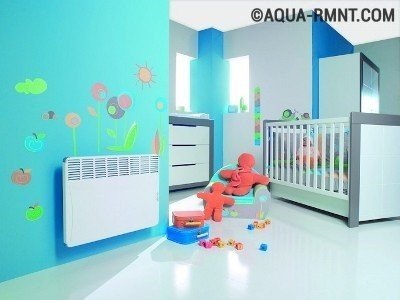

Compact convector heaters are located on the wall a few centimeters from the floor, which ensures better air heating in the room
Convector heaters also have many advantages: long operating time of the device; quick warming up of the air stream; two ways to install the model: floor-mounted (there are wheels) and wall-mounted (there is a fastening element); the presence of built-in thermostats that allow you to set the desired temperature level in the room; the ability to combine several products into a network, which allows you to provide full heating at home; operational safety; noiselessness; small size and original design.
The only drawback of convectors is the insufficiently fast heating of the air in the room to the desired parameters. This is due to the modest capabilities of natural convection.
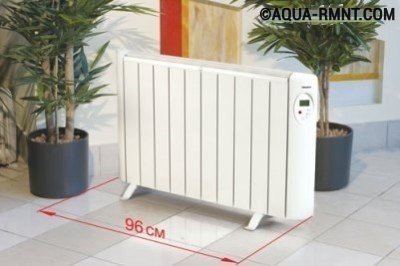

Compact models of floor convection heaters are equipped with small wheels that facilitate their free movement around the room. Easily transported to another room if necessary
Here's what you can recommend from manufacturers:
- When choosing convectors, pay attention to the products of the following manufacturers: Electrolux, Ballu, Timberk, Noirot, NeoClima, Nobo, Polaris, Stiebel Eltron, ADAX, Termor.
- Models with electronic thermostats are able to control temperature changes with an accuracy of 1 ° C.
- Select a heater for its power, which can range from 0.25 to 2.5 kW.
- Pay attention to the heating temperature of the case. For children's rooms, models are suitable, the body of which heats up to 55 ° C.
So, having got acquainted in more detail with these types of heaters, you can make a smart choice. If you intend to use the device for quick and short-term heating of the room, then choose a fan heater. If you know that the equipment will have to work for a long time, then buy a convector. Having understood whether you need a fan heater or a convector, decide on a specific model. To do this, carefully study the technical characteristics of the products sold by the manufacturer.
Noise level
For most heaters, the documentation indicates the maximum noise level. This parameter should be looked at if the heater is installed in the bedroom, in the nursery or in the study - in general, where silence is required.The quietest heaters are infrared. They are followed by oil heaters, convector-type heaters, and then fan heaters and heat guns.
It is worth considering that sometimes the noise can be emitted by a temperature relay or a speaker that notifies the user about a change in the operating mode (or is triggered when the buttons are pressed). Since these sounds can be very annoying, it is best to make sure in advance that there are no such effects. By the way, it doesn't hurt to check the brightness of the display, so that it doesn't suddenly turn out that the heater that is supposed to be installed in the bedroom is shining too brightly.
Protection
Almost all heaters have a protective system that turns them off in case of overheating. A built-in fuse or overheating sensor located at the outlet of the air will prevent fire and unnecessary stress on the power grid.
Evgeny Filimonov
Ask a Question
Many heaters also have a system that will shut off the appliance if it falls. Subject to safety precautions (the heater is correctly installed and not covered with rags and foreign objects), such systems guarantee that the device will not cause a fire.
However, it is still possible to burn yourself on many heaters. Therefore, if there are children and elderly people in the house, it is better to think about buying the safest heater that will be difficult to hook or drop (such, for example, include wall heaters).
If the heater is supposed to be installed in the bathroom, you should pay attention to the models with a waterproof case. This will allow you not to worry about water entering the device case and a possible short circuit. Using a heater in the bathroom will not only allow you to achieve a comfortable temperature, but also prevent the appearance of fungus on the walls.
Which unit is better - a fan heater or a convector
When the need for a certain heater arises, then a huge number of people may simply be completely confused about various kinds of models that are presented in our time in a huge assortment, the question arises, which is better - a fan heater or a convector?
Naturally, some models enjoy the highest level of demand and popularity of the modern type of fan heaters, which is understandable quite simply. Such devices, quite affordable and not expensive, are quite capable of heating the air for quite short periods of time, as well as providing the necessary level of microclimate for everyone in this room.
A little more time is required for convectors that are hung directly on the walls, or simply integrated into the floor. But there is also an advantage that allows such devices to work much more, which will provide the most complete heating level for a certain suburban dwelling. You need to find out what is better a fan heater or still a convector, this is what the article was created for.
For the correct and rational decision when choosing, in a certain way, you should get acquainted with the various types, in this case, with two types of such devices. Based on this, it will become most understandable and clear which of the units will fit the most correctly.
Mounting type
Different heaters allow for different installation methods. Many of them are simply placed on the floor (oil heaters) and have special wheels for moving. Others can be installed on any flat surface, such as a table or windowsill (these include many fan heaters). Such heaters do not require special installation efforts. As a maximum, the user will have to independently assemble the legs with wheels.
Also, many heaters have several mounting options for the user's choice: wall, floor, ceiling or for a suspended ceiling.At the same time, the same model can allow several installation options at once (for example, wall or ceiling). In this case, the installation will require a drill or hammer drill and other related tools with which the fasteners are installed.
Based on materials from the site: vash.market, ixbt.com


